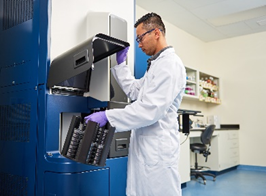blog
June 7, 2023 | Source: Rapid Micro Biosystems, Inc.
Reducing Contamination Risk for Aqueous Non-Sterile Products
POSTED BY Rapid Micro Biosystems | 7 minute read
June 7, 2023 | Source: Rapid Micro Biosystems, Inc.
POSTED BY Rapid Micro Biosystems | 7 minute read
A rising tide of water contamination events highlights the need for automated testing.
It has been disappointing to see a resurgence of water contamination issues during the past year, after all the improvements in water quality made by the pharmaceutical industry during the late 1990s and early 2000s. But a recent Pink Sheet report from industry analyst Bowman Cox notes that the U.S. Food and Drug Administration (FDA) has been forced to double down on sterility assurance after a series of contamination incidents:
Many US Food and Drug Administration drug warning letters raised concerns about inadequate sterility assurance in 2022, particularly for water systems and traditional open cleanrooms. Of the 82 drug GMP warning letters the FDA issued last year, 25 addressed shortfalls related to sterility, making it the third most common problem area after investigations and testing. The emphasis on water systems came as one recalcitrant CEO, who insisted on using contaminated water, wound up in prison.
The report also cites remarks from FDA official Francis Godwin at last September’s Parenteral Drug Association/FDA conference, noting that of the 60-plus warning letters his office had issued over the prior year, 10 related to poor water quality in pharmaceutical manufacturing.
Needed: Better In-process Water Testing
Water is a common manufacturing component in non-sterile oral and injectable drugs, as well as personal care products. This increases the potential for microbial growth during production and storage. While the risk of microbial growth during a product’s manufacture or shelf life can be partially mitigated by antimicrobial preservatives, the most recent FDA draft guidance for microbiological quality considerations in non-sterile drug manufacturing warns that preservatives can provide a false sense of security.
Certain microorganisms have been found to degrade commonly used preservatives, despite the drug having previously met antimicrobial effectiveness testing acceptance criteria. Consequently, non-sterile drug manufacturers should be aware of the potential for the development of preservative resistance.
FDA has noted that preservatives are no substitute for a comprehensive approach to preventing objectionable microorganisms from contaminating non-sterile drugs, and they should not be presumed to reduce in-process bioburden during manufacturing. The agency points out that “it is important for manufacturers to have a robust design for water systems, including controls designed to prevent objectionable microorganisms and procedures for monitoring, cleaning, and maintenance.”
Maintaining such a robust water system is no easy task, given the high volumes that must be tested and analyzed for effective quality control (QC) – particularly if your sample enumeration, tracking, and reporting still rely on manual processes. So, what can you do? This much is clear: the commercial and human cost of contaminated water systems is far too high to justify staying with antiquated manual processes.
Automated Testing That’s Fast, Accurate, and Fully Digitized
In an industry looking for new answers, the best choice has actually been around for a long time.
For more than 15 years, our Growth Direct® System has been routinely used by pharmaceutical manufacturers to enumerate water microorganisms. Combining advanced robotic automation, powerful optical imaging, algorithmic vision analysis, and integrated data management, the Growth Direct® System facilitates better control of site water systems through earlier detection times of contamination issues. Our technology also helps boost productivity in QC Micro labs, reducing a dozen or more operations in the traditional microbial method to two simple steps.
Even more appealing for risk-averse companies, the technology is generally accepted as an automated compendial method. Its proven status and extensive track record facilitate a streamlined validation process, only requiring verification of the system enumeration accuracy followed by equivalence testing.

At one therapeutic protein production site, the Growth Direct® System detected an organism excursion in 24 hours compared to seven days with traditional methods – prompting immediate sanitizing and saving up to six manufacturing days.
One striking example of in-process bioburden reduction with the Growth Direct® System took place at a Top 20 global pharmaceutical company, which installed a unit for water testing at a site producing therapeutic proteins. During a serious water contamination event, an organism excursion that would traditionally require seven days to identify was instead detected in 24 hours; the entire water system was sanitized immediately and rapidly brought back online, saving up to six manufacturing days and potentially millions of dollars in product that would have otherwise been lost to contamination.
Not long afterward, our customer brought additional systems online at the same site – then implemented the Growth Direct® System globally, spanning eight sites worldwide.
If you are challenged to reduce contamination risk in aqueous non-sterile products, don’t risk adding your company to the growing list of companies impacted by an FDA warning letter. Arrange a demo of the Growth Direct System® or contact Rapid Micro Biosystems today.
Blog by David L. Jones, Director of Industry Affairs at Rapid Micro Biosystems.
References
Warning Letters Special Report: A Focus on Sterility Risks from Water Systems, Open Cleanrooms
Statistical Testing Recommendations for a Rapid Microbiological Method Case Study
Validation of the Growth Direct® System to Perform Pharmaceutical In-Process Bioburden Analysis
Microbiological Quality Considerations in Non-sterile Drug Manufacturing (Draft Guidance)